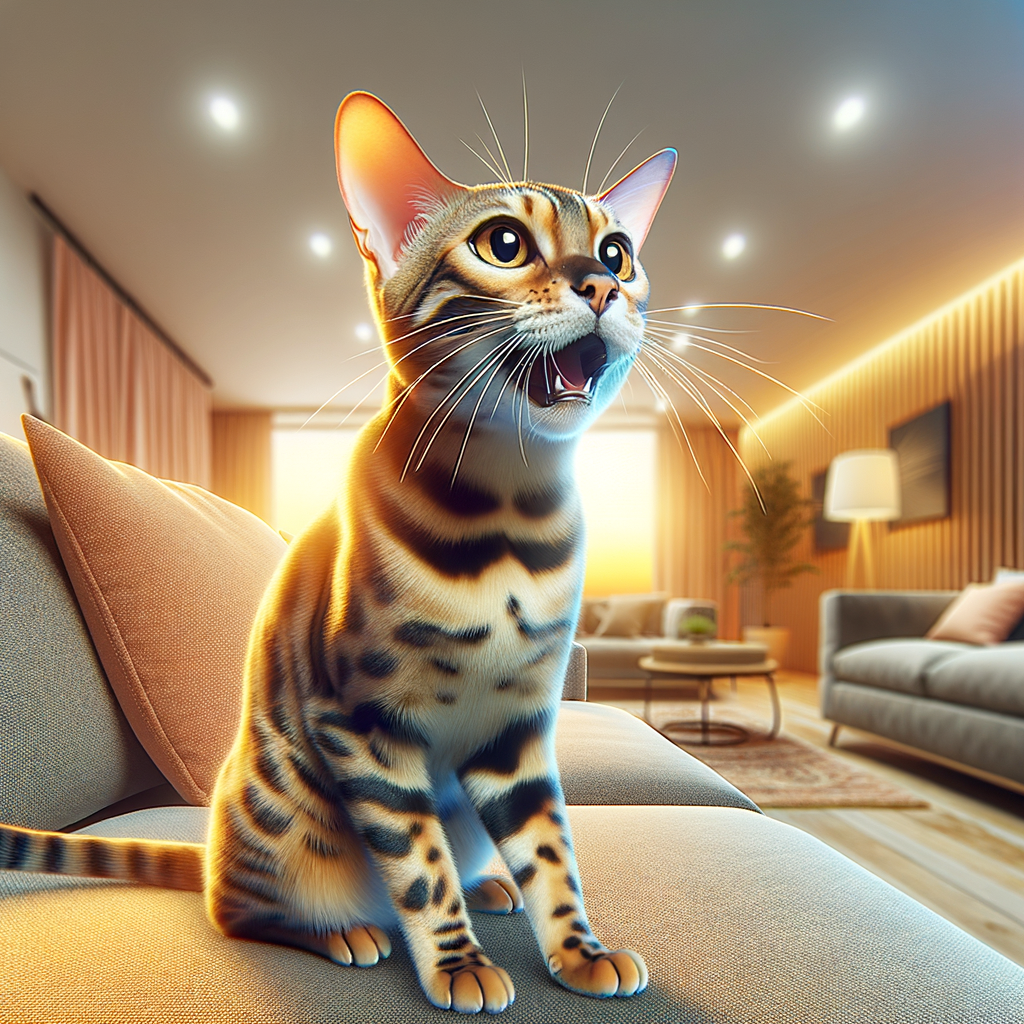
Introduction to Bengal Cat Communication
- Overview of Bengal cat behavior: Bengal cats are known for their playful and energetic nature. They are very active and love to explore their surroundings. They are also quite vocal and will often “talk” to their owners.
- Bengal cat signals: Just like humans, Bengal cats have their own ways of communicating. They use a mix of vocalizations, body language, and behavior to express themselves. By learning to read these signals, you can better meet their needs and ensure they are happy and healthy.
Bengal Cat Vocalizations
Common Bengal Cat Sounds
- Interpreting Bengal cat meows
Bengal cats are known for their unique and expressive meows. These meows can vary in pitch and length. A short, high-pitched meow often means your Bengal is happy or excited. On the other hand, a long, drawn-out meow might indicate that your cat is feeling lonely or wants attention.
According to a study from the University of Sussex, cats use different meows to communicate with humans compared to other cats. This means your Bengal is trying to tell you something specific with each meow.
- Decoding other Bengal cat vocalizations
Bengal cats don’t just meow; they also make other interesting sounds. These include chirps, growls, and purrs. Each sound has a different meaning:
- Chirps: These are often used when a Bengal is excited or sees something interesting, like a bird outside the window.
- Growls: A growl usually means your cat is feeling threatened or scared. It’s a warning to back off.
- Purrs: Purring is a sign of contentment and comfort. If your Bengal is purring, it means they are happy and relaxed.
| Sound | Meaning |
|---|---|
| High-pitched meow | Happiness or excitement |
| Long meow | Loneliness or need for attention |
| Chirp | Excitement or interest |
| Growl | Feeling threatened or scared |
| Purr | Contentment and comfort |
What Different Sounds Mean
- Meaning behind different types of meows: Bengal cats use different meows to express their needs and feelings. A short, soft meow often means they want attention or food. A loud, insistent meow might indicate they are upset or in pain. Pay attention to the context and frequency of the meows to better understand your cat’s needs.
- Other vocal signals: Besides meowing, Bengal cats use other sounds to communicate. Purring usually means they are happy and content, but it can also be a sign of discomfort. Growling or hissing indicates fear or aggression. Chirping and chattering are often heard when they are excited or watching birds outside. Recognizing these sounds helps you respond appropriately to your cat’s emotions.
Deciphering Bengal Cat Body Language
Common Bengal Cat Body Postures
- Tail SignalsThe tail of a Bengal cat can tell you a lot about how they feel. Here are some common tail signals:
Tail Position Meaning Upright and Quivering Excited or Happy Puffed Up Scared or Aggressive Low and Tucked Submissive or Anxious Slowly Wagging Annoyed or Irritated For example, if your Bengal cat’s tail is upright and quivering, they are likely very happy to see you. On the other hand, a puffed-up tail means they are scared or ready to defend themselves.
- Interpreting Ear and Eye SignalsBengal cats also use their ears and eyes to communicate. Here are some signals to watch for:
Ear Position Meaning Forward Interested or Curious Flat Against Head Scared or Angry Swiveling Listening to Sounds Eye Signal Meaning Slow Blinks Relaxed or Trusting Wide Open Alert or Excited Narrowed Annoyed or Aggressive For example, if your Bengal cat’s ears are forward and their eyes are slowly blinking, they feel safe and happy. However, if their ears are flat and their eyes are narrowed, they might be feeling threatened.
What Different Postures Mean
-
Decoding Aggressive Postures:
- Arched Back: This means the cat is ready to defend itself. The cat’s fur may also stand up, making it look bigger.
- Flattened Ears: This shows the cat is angry or scared. Flattened ears are a clear sign to stay away.
- Hissing or Growling: These sounds mean the cat feels threatened. It is best to give the cat space.
-
Submissive Postures
- Crouching Low: The cat may crouch low to the ground, trying to make itself look smaller.
- Tucked Tail: A tail tucked between the legs shows fear or submission.
- Avoiding Eye Contact: The cat may look away to show it does not want to challenge you.
Bengal Cat Communication Tips
How to Communicate Effectively with Your Bengal Cat
- Using vocal cues to communicate: Bengal cats are known for their vocal nature. They often use different sounds to express their needs and emotions. For example, a short, soft meow might mean they want attention, while a loud, insistent meow could indicate hunger. To communicate effectively, try mimicking their sounds. This can help build a stronger bond and make your cat feel understood.
- Using body language to communicate: Body language is another key way Bengal cats communicate. Pay attention to their tail, ears, and posture. A tail held high usually means they are happy and confident, while a low or tucked tail might indicate fear or anxiety. By observing and responding to these cues, you can better understand your cat’s feelings and needs.
Responding to Your Bengal Cat’s Communication
- How to respond to meows:Bengal cats use meows to communicate with their owners. When your Bengal cat meows, pay attention to the tone and frequency. A high-pitched, frequent meow might mean they are hungry or need attention. Respond by checking their food and water bowls or giving them some playtime.
If the meow is low and drawn out, it could indicate discomfort or stress. In this case, try to identify any potential issues in their environment, such as a dirty litter box or a new, unfamiliar object.
- How to respond to body language:Bengal cats also communicate through body language. For example, if your cat’s tail is puffed up and they are arching their back, they might be scared or agitated. In such cases, give them some space and avoid making sudden movements.
On the other hand, if your Bengal cat is rubbing against you or kneading with their paws, they are showing affection. Respond by petting them gently and speaking in a calm, soothing voice.
Pay attention to their ears and eyes too. Ears flattened back and wide eyes can indicate fear or aggression, while relaxed ears and half-closed eyes usually mean they are content.
Bengal Cat Social Behavior
How Bengal Cats Communicate with Other Cats
-
Bengal Cat Interaction
Bengal cats are known for their playful and energetic nature. They often interact with other cats through play. This can include chasing, pouncing, and wrestling. These activities help them bond and establish social hierarchies.
Note that Bengal cats are very social and enjoy the company of other cats. They use a variety of behaviors to communicate, such as grooming each other, which shows affection and builds trust.
-
Decoding Social Signals
Signal Meaning Tail Up Friendly greeting Hissing Feeling threatened or annoyed Rubbing Marking territory or showing affection For example, when a Bengal cat raises its tail, it is usually a friendly greeting. On the other hand, hissing indicates that the cat feels threatened or annoyed. Rubbing against another cat is a way to mark territory or show affection.
How Bengal Cats Communicate with Humans
- Recognizing Signs of Affection
Bengal cats show their love in many ways. They might rub their head against you, which is called “head bunting.” This is their way of marking you with their scent, showing that they trust and love you. Another sign is purring. When a Bengal cat purrs, it often means they are happy and content. They may also knead with their paws, a behavior they carry from kittenhood when they knead their mother’s belly for milk.
- Signs of Distress
Signs of distress can include hiding, hissing, or growling. If your cat is avoiding eye contact or has a low, tense body posture, they might be scared or anxious. Excessive grooming or changes in eating habits can also be signs that something is wrong. Always pay attention to these signals and consult a vet if needed.
| Behavior | Meaning |
|---|---|
| Head bunting | Showing affection and marking you with their scent |
| Purring | Feeling happy and content |
| Hiding | Feeling scared or anxious |
| Hissing/Growling | Feeling threatened or distressed |
The Importance of Understanding Your Bengal Cat
- Summary of key takeaways
| Key Insight | Details |
|---|---|
| Vocalizations | Bengal cats use different sounds to express themselves. Learn what each sound means. |
| Body Language | Watch their tail, ears, and eyes. These can show if they are happy, scared, or curious. |
| Social Behavior | Bengal cats are social and love interaction. They enjoy playing and being with their family. |
- Final thoughts on Bengal cat communication
This knowledge helps you respond to their needs better. Every cat is unique. Spend time observing and interacting with your Bengal to understand them fully.






